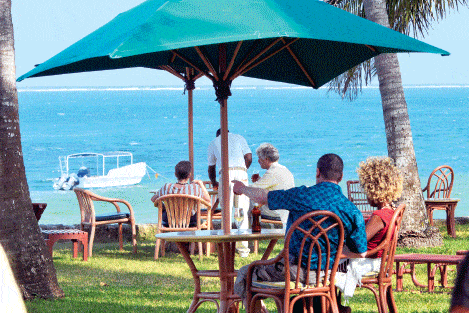
In East Africa, wildebeests are currently on the move, challenged by northern Tanzania’s long dry season, which begins around now (late May or early June). I too, am making my own trek of sorts. I’m in the process of relocating from southern California to the Pacific Northwest. I guess you could say that much like wildebeests, I am also literally in search of “greener pastures.”
Attracted by seasonal fluctuations of precipitation and vegetation growth, the peculiar-looking antelope called wildebeests have commenced on a lengthy and treacherous journey of survival. Their fate may rest in the jaws of crocodiles and terrestrial carnivores like lions and hyenas.
In my case, plans were delayed for travel to Africa this summer to participate in a cheetah reintroduction project in Namibia. So I decided, while traveling north through Santa Rosa, California, that I would visit Safari West.
I couldn’t make it to southern Africa this year, but by mere coincidence, I had the good fortune of driving north through Santa Rosa, not far from the renowned Safari West zoological park, which was built in 1989.
The California-based wild animal attraction is a 400-acre African game animal preserve owned and operated by seasoned professional animal care experts and conservationists Peter and Nancy Lang. The Langs offer one of the best venues on the planet for those seeking to embark on an African wildlife safari. The Sonoma Safari, as their preserve is sometimes called, afforded me a chance to see some African wildlife while closer to home.
Safari West may authenticate the wildlife safari experience beyond what any other captive wildlife facility can begin to provide outside of the African continent.
The safari park is extremely accessible—it sits at the epicenter of a world-class tourist destination. Only seventy miles north of San Francisco in coastal Sonoma county, the Safari West campus is a sprawling, expansive preserve within a minutes drive of the country’s finest wineries. If you are not a wine aficionado, or even a safari enthusiast, the region still offers something for the seasoned traveler. And Sonoma is all about catering to green and sustainable living, as is Safari West.
There are several Association of Zoo and Aquarium (AZA) accredited safari parks in the U.S., including San Diego Zoo Global’s Safari Park, Fossil Rim Wildlife Center in Glen Rose, Texas, the Columbus Zoo’s The Wilds, Florida’s Lion Country Safari, and Oregon’s Wildlife Safari to name a few. However, unlike these other venues, Safari West is dedicated to the exclusive display and conservation breeding of African mammals and birds through luxury ecotourism. Having been to most of the safari parks in North America, I can say that Safari West may be the best at striking a balance between safari viewing and up close and personal encounters with wildlife ambassadors.
One of six privately owned AZA facilities, Safari West offers overnight lodging, customized guided tours, and experiences for the more frugal patron. The high-end dining and tenting offers something for couples and families willing to spend a few extra dollars. But Safari West also caters to guests interested in more conventional and inexpensive experiences offered by only a handful of zoological parks. In addition, the staff offer private and intimate behind-the-scenes tours of animal enclosures and holding areas.
Nearly 900 animals, representing approximately 100 animal species, roam the campus of the enclosed wooded and grassland “habitats” that comprise Safari West. Herds of browsing Masai and reticulated giraffe can be seen a few feet away in converted troop carriers or on foot (that is, if their heads are not already hovering directly above yours). The all-terrain vehicles also take guests out for a three or more hour adventure to see nearly 20 species of the approximately 70 extant species of African antelope.
From grazing sable, to roan antelope, to wildebeests, which dominate the preserve’s landscape reminiscent of the East African savanna, the park offers an unprecedented and unpredictable wildlife viewing opportunity. Guests can observe both common antelope and more conservation sensitive species in social groups. The scimitar-horned oryx, which is extinct in the wild, can be viewed from a distance and from up-close, as can white rhino and my favorite forest antelope—the bongo. Safari West also offers visitors a chance to see cheetah and serval at just a few feet away along with fennec foxes, which are native to north Africa.
Marie, the lead keeper of carnivores, introduced us to the preserve’s cheetah residents and shared their individual histories. My guest Mieshelle Nagelshneider, a well-known domestic cat behaviorist, said she had never been so close to a cheetah and she has worked with wild cats before.
Marie also toured us through two expansive outdoor aviaries, which permit flight enclosure walk-throughs with spoonbills, ibises, demoiselle cranes, and an array of other avian fauna. Mixed mammal and bird enclosures include the likes of crowned cranes, a species which I mentioned to staff that I had literally been attached to at one point in my zoo keeping career. The park also provided me with some great photographs of saddle-billed storks— large, beautifully plumaged birds that I have come to respect as potentially flighted and formidable hazards to humans. (Click here for more information regarding the avian residents at Safari West.) Mieshelle and I also got a chance to meet some hand-reared southern ground hornbills. The species, endemic to Africa, is one of the longest-lived among all bird species and about as charismatic as can be.
Along with adventurous road excursions and exhilarating animal encounters, the “Sonoma Safari” offers picturesque vistas and great photo opportunities of Africa’s most charismatic wildlife. The private and customized packages, are not unlike premier wildlife conservation safaris offered by some of the top Safari outfitters in East Africa’s Serengeti-Mara ecosystem, like Safari Professionals. In fact, the vast majority of Safari Professionals’ African safaris are designed around the Serengeti wildebeest migration. Tom LaRock, the founder and managing director of Safari Professionals and former executive director of Friends of the National Zoo said, “While Safari West will provide a wonderful glimpse of these fascinating antelopes, the sight of thousands of white-bearded wildebeests trooping across the rolling grasslands will take your breath away.” Safari Professionals has been operating in the Serengeti-Mara Ecosystem for nearly 30 years, and has created some of the most intriguing and exciting wildlife viewing safaris available in Africa.
As our other guide, Erica, the lead keeper of hoof stock at Safari West, drove us from the giraffe barn toward the spacious ungulate paddocks, we could see zebras, kudu, smaller antelope, and Cape buffalo gather in loose herds reminiscent of the faunal assemblages of the real-life African plains. Rolling grasslands of coniferous and deciduous forestland interspersed with glistening watering holes offer as close to a natural habitat as you can find for species like blue wildebeests in North America. Safari West may not support stands of drought-tolerant acacia trees like the Serengeti-Mara ecosystem, but upon cursory viewing, the preserve looks much like the Serengeti.
In fact, when we reached a herd of blue wildebeests, followed by a lone impala, I couldn’t help, but think of the epic transboundary trek these animals make from Tanzania’s vanishing grassland grazing refuges to Kenya. The Great Migration has often been referred to as the Greatest Nature Show on Earth. As Tom pointed out, National Geographic recently reported on field research findings that indicate that the zebra migration between Namibia and Botswana in southern Africa is actually longer than the Serengeti migration.
So if you can’t afford to spend the money or take time off to travel to East Africa to see the mass migratory movement of odd-looking ruminant herbivores and striped equids surrender themselves to natural processes, you can visit Safari West to see the next best thing.
As our guide navigated our ancient, but uber-durable vehicle over rough terrain, we bounced from our seats and soon caught sight of some wildebeest cows and calves on the slope of a grassy knoll. I envisioned these animals preparing for their migration across the Serengeti-Mara Ecosystem (Greater Serengeti Area).
Always following the rains and subsequent grass growth, the Great Migration of wildebeests, is considered to be one of the longest and largest migrations across a terrestrial landscape for any animal on Earth. In terms of animal density and biomass, nothing in East Africa exceeds or otherwise compares to that of over one million wildebeests on the move.
Along with the Sahara Desert, the Serengeti is one of the “Seven Natural Wonders of Africa.” Mere mention of the name of the East African ecosystem or the protected Serengeti National Park conjures up an iconic image of a wildlife safari.
Again, if you’re not lucky enough to be one of a couple hundred thousand yearly visitors to the Serengeti, you may want to embrace a more convenient excursion to Safari West. Of all the national parks spread throughout the Greater Serengeti Area, I most liken Safari West to the famed savanna landscape because of the species composition of both places and the popularity of the Serengeti among African safari destinations.
Safari West, in my opinion, is a microcosm of Serengeti National Park, which is widely considered to be the best known of the country’s 15 national parks and perhaps the best known of all the East African national parks. I marveled at Peter and Nancy Lang’s creation, and they shared their sentiment as stewards of African wildlife and as dedicated conservationists. “We owe it to each other and to the majestic creatures with whom we share this planet to teach, educate, and inspire not only the next generation, but subsequent ones as well. We can, we should, we must dedicate ourselves to living in a world that values all living creatures, great and small,” they said.
In addition to a world-class wildlife attraction, the Langs created the Safari West Foundation. The charitable non-profit “helps people of all ages develop a deeper appreciation of the natural environment and wildlife conservation.” They wanted to give back in a way that is consistent with the mission of the Safari West Preserve, which is “wildlife preservation through breeding, education, research, and public interaction.”
Serengeti National Park is not only well known around the world, it is also the largest national park in Tanzania. Established in 1951, the park nears the size of the U.S. state of Connecticut, and aisde from wildebeests, hosts the largest populations of large herbivores and carnivores in the world.
The larger Serengeti ecosystem is a geographical region southeast of Lake Victoria in northern Tanzania. The region, which in the Maasai language translates into “Endless Plains,” is actually home to a diversity of natural grassland and open woodland landscapes. The transboundary ecosystem spans northeast across the southwest border of Kenya to a designated protected area called the Maasai Mara National Reserve. Together the two protected areas are part of the Serengeti-Mara ecosystem.
The Serengeti may be most famous for the annual migrations of wildebeests, but fewer numbers of other antelope species also make the journey. A faunal assemblage of other resident ungulate herbivores, including Cape buffalo and zebra, comprise the diversity of megafauna inhabiting the region. According to Tom LaRock, “While there are resident zebra throughout the Serengeti-Mara ecosystem, zebras also migrate with the wildebeest.” Estimates vary, but the National Geographic article about African mammal migrations states that the migration consists of 1.2 million wildebeest and 750,000 zebras.
I certainly urge you to visit Safari West, and if resources permit, by all means join Safari Professionals on a trip to East Africa. Both opportunities will make your dream safari come true.







